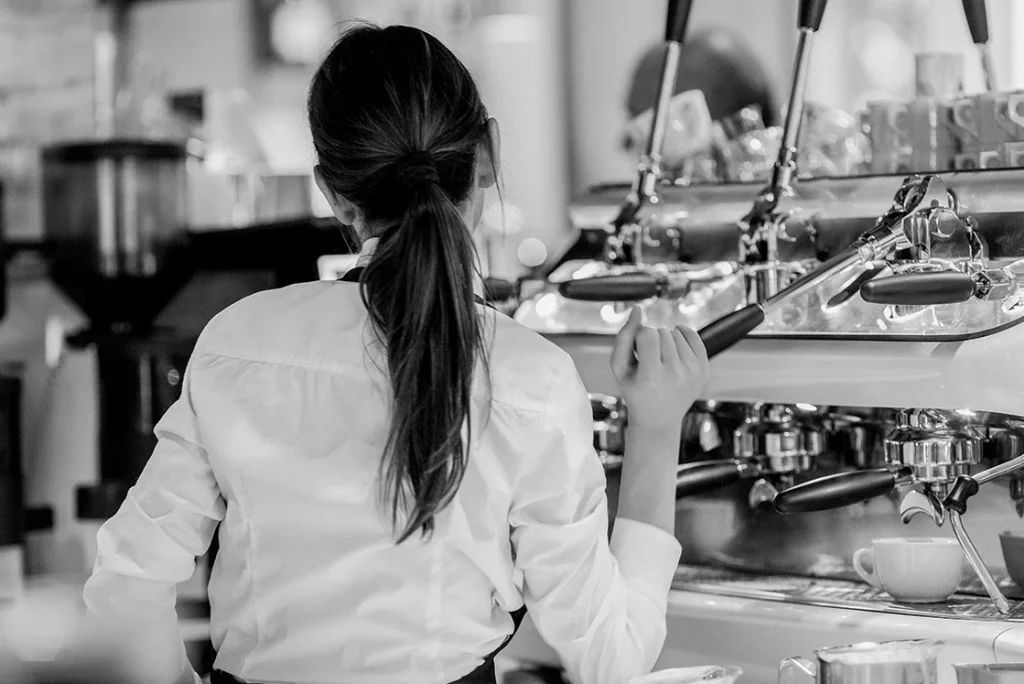For over a hundred years, La San Marco has been expressing its inclination for innovation and excellence through the search for cutting-edge solutions from both a technological and aesthetic point of view. Its coffee machines have marked the history of espresso and significantly contributed to the spread of an Italian-style coffee culture throughout the world.
With the same passion and awareness, we want to make available to readers a small glossary around the world of espresso coffee and coffee machines in the belief that knowledge is an indispensable key to access a conscious and passionate experience. Although it is certainly not exhaustive, we hope it will be able to convey in an understandable and immediate way the complexity of the elements that revolve around a simple cup of espresso coffee. Enjoy reading!
Sensory analysis
It is a science based on the objective evaluation of parameters related to tastes, aroma, body, as well as the image of a product. The organoleptic characteristics of a coffee are perceived with sight, smell, taste, touch.
Sensory analysis
It is a science based on the objective evaluation of parameters related to taste, aroma, texture, as well as the image of a product. The organoleptic characteristics of a coffee are perceived by sight, smell, taste, and touch.
Bar
Unit of measurement used to measure the water pressure in the espresso brewing.
Extraction chamber
It is the element composed of the water delivery shower and the filter. The correct sizing of the extraction chamber and therefore of the filter is very important for a correct extraction. To correctly size the extraction chamber it is important to leave a small free head space between the coffee cake and the hand shower of at least 2 mm. This space will be filled by the volume expansion of the ground coffee once the extraction water reaches the coffee, inflating it.
Espresso “crema”
It is the layer of foam that forms during the preparation of the espresso in the cup due to the presence of gas, especially CO2, released during the percolation of hot water through the roasted coffee powder. The “crema” has an alveolar structure formed by gas bubbles next to each other. The cream has a “cap” function that does not allow the aromas present in the drink to disperse in the air. The presence of the “crema” defines the very nature of the espresso.
Espresso
Espresso coffee is one of the symbols of Italian excellence. The name of the drink originates both from the fact that the extraction is done on the spot – and therefore expressly prepared for the customer – and from the speed of the action. Technically, espresso is defined as a biphasic drink characterized by a liquid part where water-soluble compounds present in coffee are dissolved and a creamy part where the fat-soluble ones are emulsified. The volume of an espresso can vary between 25 and 35 milliliters extracted in a time between 20 and 30 seconds.
Flush
Also known as “purge” operation that is performed on the espresso coffee machine between one extraction and the next, in order to eliminate any residues of exhausted coffee powder that have remained attached to the shower of the brewing unit from the previous brewing. The same operation can also be performed on the steam wand before and after frothing the milk in order to eliminate any milk residues that have been sucked into it.
Brewing group
Component of the espresso coffee machine that distributes hot water evenly onto the coffee cake through the shower. The filter holder containing the filter and the portion of ground and pressed coffee is attached to the brewing group.
In the lower part there are the dispensing spouts that direct the flow of coffee coming out of the filter into the cups.
Lever
The first lever machine designed and built by La San Marco dates back to 1945. This technology requires each brewing group to be manually operated by the barista using a lever capable of imparting a certain pressure to the brewing water. What makes the lever system truly unique are the two main elements of the extraction process: the water temperature and the pressure profile. The water is fed directly from the boiler and after a short preinfusion period it crosses the coffee cake at variable pressure starting from an initial value much higher than the electronic machines, to extract the noblest aromatic notes and generate a persistent cream, up to the point of interruption decided by the experienced barista. Today, thanks to the exclusive LEVA CLASS® technology, the lever system developed by La San Marco represents the noblest method of espresso extraction, in full compliance with international safety standards.
Grinder-doser
Since ground coffee loses its aroma after about 20 minutes from grinding, it is important to grind the coffee in a dosed manner. The coffee grinder is therefore an essential tool which, in addition to carrying out the function of grinding the coffee, allows it to be dosed in the correct quantity as per setting.
On-demand coffee grinder
This is an instant grinding machine, with sophisticated technological and design solutions, capable of delivering the ideal amount of ground coffee directly into the filter holder as needed, without depositing in a dispenser or reservoir.
Grinder
Since ground coffee loses its aroma after 20 minutes that it has been ground, it is important to grind the coffee in a metered manner. Therefore, the coffee grinder is an essential tool that not only performs the function of grinding coffee, but also allows it to be dosed in the right established amount.
Multi-boiler
Thanks to this technology, the hydraulic circuits of each single extraction group and of the hot water-steam boiler are independent. This allows to set different temperatures for each coffee group with the advantage of being able to dispense drinks with different sensory profiles even if starting from coffee of the same botanical species and with the same roasting profile. Furthermore, thanks to the various innovations developed by La San Marco connected to the multi-boiler technology, it is possible to set a customizable temperature profile for each dose of coffee according to the raw material available.
Pressing
The operation through which the portion of coffee in the filter is levelled and compacted. The coffee pressed into the filter has the advantage of absorbing the first water that arrives in the pre-infusion phase more homogeneously, as well as increasing its volume on the arrival of the water in a regular way, offering it a better hydraulic resistance.
Pressure
The role of water pressure on percolation is a factor of absolute importance for delivery. The pressure during percolation can remain constant at 9 bar during brewing, or vary according to the characteristics of the hydraulic circuit of the espresso machine. Thanks to the technologies developed by La San Marco it is possible to design a specific pressure profile which, together with the calibration of the other extraction parameters, can help to achieve the best quality in the cup. In this case, each profile produces a different quality of the espresso.
Specialty Coffee
With this terminology we mean a green coffee of the highest quality, roasted in order to best express its aromatic potential and extracted according to precise standards in order to obtain at least 80 tasting points according to the cupping protocol (also called Brazilian cupping) defined by the Specialty Coffee Association. Attention is therefore placed not only on the final product, but also on each step of the supply chain, from its origins to the professionalism of the barista who performs brewing.
Temperature
The temperature of the extraction water has great importance on the quality of the espresso. Even small differences in the order of 0.3 ° C can affect the drink by changing its sensory characteristics. Some models of La San Marco machines allow the setting of different temperature profiles in order to modify the extraction parameters at the discretion of the expert barista.
Brewing duration
It is usually divided into two phases. The first one corresponds to the time calculated from the moment the electric pump is activated until the first drops of espresso come out of the portafilter spouts. The second phase is the percolation time which is calculated from the end of the first infusion to the end of brewing.



Since 1920, La San Marco has represented excellence in the production of espresso machines. It is a recognized leader in the segment of machines with the traditional lever system. It also produces a wide range of traditional, automatic and semi-automatic machines, and capsule machines, grinders and other professional equipment for bars, restaurants and hotels, which it distributes worldwide.
SIGN UP FOR THE NEWSLETTER
La San Marco S.P.A.
Via Padre e Figlio Venuti, 10 – 34072 – Gradisca D’isonzo (GO) – Italy Tel. (+39) 0481 967111 – Fax: (+39) 0481 960166 – Info@lasanmarco.com – lasanmarcospa@pec-mail.It – C.F. 00157550302 – P.Iva 00518180310 – Reg. Impr. Gorizia N. 00157550302 – Capitale Sociale EUR 7.000.000 i.v.
Subject to management and coordination by Groupe Seb SA